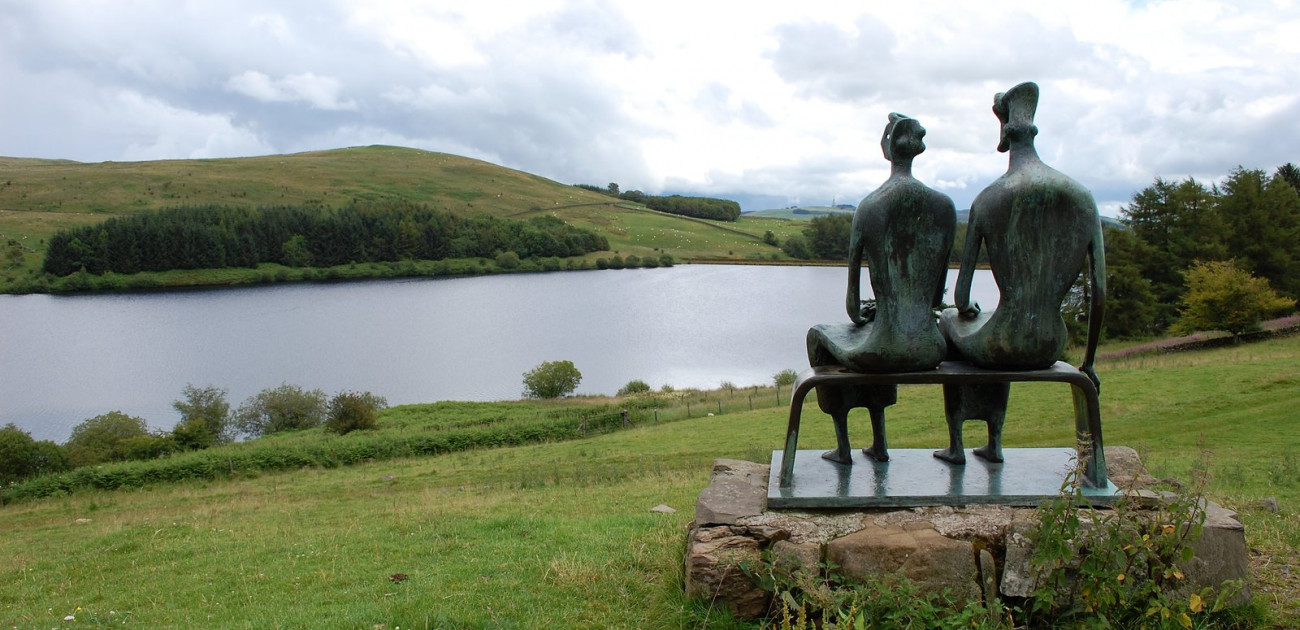02 August 2011
Walk Around Some Of Glenkiln Sculptures (16 July 2011)

Sometimes you come across something truly beautiful. Something simple, yet seemingly perfect. So it was the other day when, on the way from a week near Kirkcudbright in Dumfries & Galloway we turned off the A75 near Dumfries to Shawhead and then to Glenkiln. My parents had given us the heads up about the Glenkiln Sculptures.
Nestled amongst the gentle lowland hills in the Borderlands, Sir William Keswick, a local laird, has placed statues by Epstein, Moore and Rodin. While open to the public, the Glenkiln sculptures are kept beneath the radar screen as unscrupulous vandals have attacked them in the past for their nihilist follies. Anyway, you drive up single track lanes until you reach the head of the Glenkiln Reservoir and park in a tiny car park beside an sculpture by Auguste Rodin “St John the Baptist”, who stands in classical poise on top of a small mound surveying the glen and the black faced sheep. It is a strong, masculine and Romano-Grecian style of artistry of a taught muscled St John who holds out his arm with a crooked finger beckoning to us the people, the flock (or perhaps the sheep are the flock and we are the sheep). The sculpture is a statement of what Rodin could do before he found his own more fluid and sensuous style. But remember this is not Florence with Donatello’s "David" or Paris with Rodin’s “The Thinker”, because here we are in the Anglo-Scottish Borderlands.

From there, we walked up Shiel Head past a pink painted farmhouse, Margreig, to the brow of the hill to what from a distance looks like a Celtic cross blessing the hill since time immemorial, The Glenkiln Cross. But as you get closer the cross becomes angular shapes, that become more curved and fluid. Then as we reached the summit, it seemed to morph into an abstract male form, a dismembered torso, that suggested Michelangelo’s David across the glen. Although modern and abstract, this sculpture has the feel of a muscular male, but with less strength than languid, gym-trained muscularatory. Taught muscles that hint at gym strength with real-life weakness that comes from a beautifying physique, rather than the brute physical strength of warriors like the Campbells or Douglases from when these Borderlands were fought over by real men and women. Or perhaps it lends itself more to abstract Mayan and Mexican art with its flowing forms and motifs. Then as we went down the hill it became a cross again.

We then went back to the other end of Glenkiln Reservoir to the Henry Moore “King And Queen”. I parked in a lay-by and walked up a slight incline to this most exquisite of sculptures. This pair sits quietly contemplating the view towards Skeoch across the water. It is a truly intimate piece with this delightful pair lovingly sitting, close to each other, happy and peaceful in their own moment of quietness. This King and Queen are an old couple, comfortable in each others’ company, solid together but becoming weaker with age. The lines and forms are brilliantly simple with a minimal of detail that conjures up the idea of people, one male and the other female.

It is two people enjoying a moment together, absorbing the view and thinking back over their lives. They seem to be considering the view, where humans have reshaped the glen, damning the Old Water to build this small reservoir. The manmade water has its own beauty like a loch, but the old environment was destroyed to create this new artificial one. What does humanity do in its own name to satisfy its desire for progress? Is it good or bad? Why must we destroy something that nature made to create something new that man made? We have dug up ores and wrought metals to make this gorgeous statue and built a picturesque lake, yet at what damage. The King asks the Queen “Did we do good?” and she answers “Only time will tell, my dear, but we tried our best. Isn’t it a beautiful view?”

And I walked back down the hill and, while we had not seen all the statues, we all drove to Northumberland as time was pressing and the children had lost interest.




